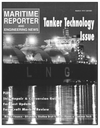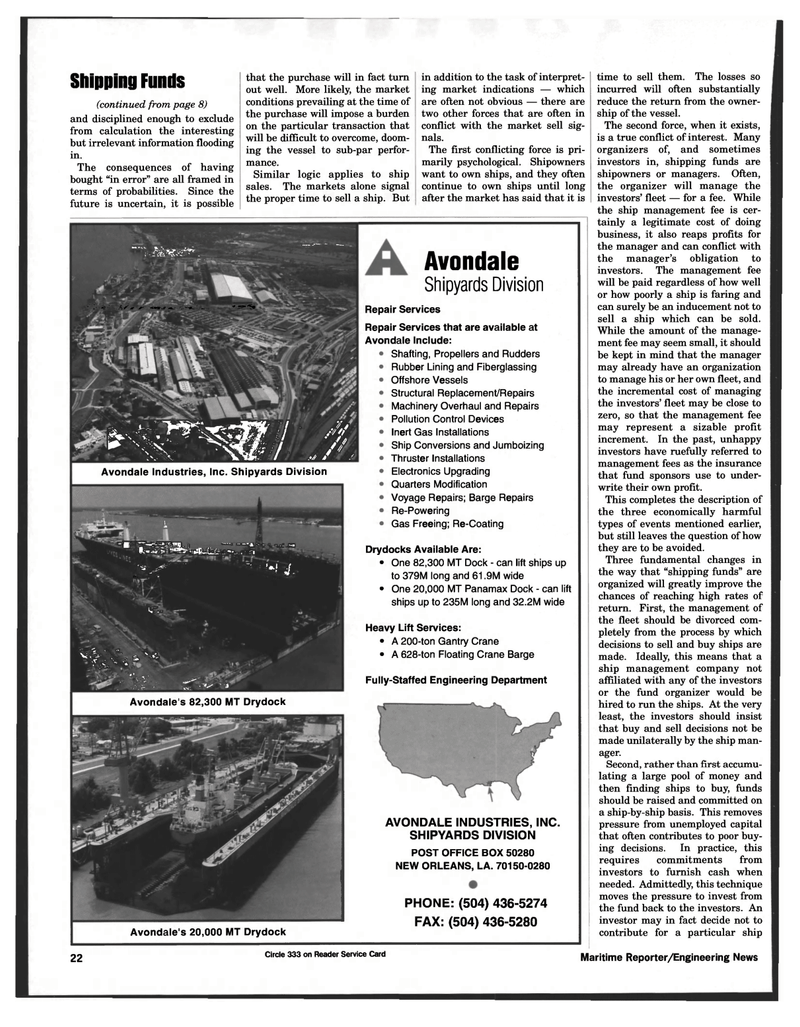
Page 22: of Maritime Reporter Magazine (March 1997)
Read this page in Pdf, Flash or Html5 edition of March 1997 Maritime Reporter Magazine
Shipping Funds (continued, from page 8) and disciplined enough to exclude from calculation the interesting but irrelevant information flooding in.
The consequences of having bought "in error" are all framed in terms of probabilities. Since the future is uncertain, it is possible that the purchase will in fact turn out well. More likely, the market conditions prevailing at the time of the purchase will impose a burden on the particular transaction that will be difficult to overcome, doom- ing the vessel to sub-par perfor- mance.
Similar logic applies to ship sales. The markets alone signal the proper time to sell a ship. But in addition to the task of interpret- ing market indications — which are often not obvious — there are two other forces that are often in conflict with the market sell sig- nals.
The first conflicting force is pri- marily psychological. Shipowners want to own ships, and they often continue to own ships until long after the market has said that it is time to sell them. The losses so incurred will often substantially reduce the return from the owner- ship of the vessel.
The second force, when it exists, is a true conflict of interest. Many organizers of, and sometimes investors in, shipping funds are shipowners or managers. Often, the organizer will manage the investors' fleet — for a fee. While the ship management fee is cer- tainly a legitimate cost of doing business, it also reaps profits for the manager and can conflict with the manager's obligation to investors. The management fee will be paid regardless of how well or how poorly a ship is faring and can surely be an inducement not to sell a ship which can be sold.
While the amount of the manage- ment fee may seem small, it should be kept in mind that the manager may already have an organization to manage his or her own fleet, and the incremental cost of managing the investors' fleet may be close to zero, so that the management fee may represent a sizable profit increment. In the past, unhappy investors have ruefully referred to management fees as the insurance that fund sponsors use to under- write their own profit.
This completes the description of the three economically harmful types of events mentioned earlier, but still leaves the question of how they are to be avoided.
Three fundamental changes in the way that "shipping funds" are organized will greatly improve the chances of reaching high rates of return. First, the management of the fleet should be divorced com- pletely from the process by which decisions to sell and buy ships are made. Ideally, this means that a ship management company not affiliated with any of the investors or the fund organizer would be hired to run the ships. At the very least, the investors should insist that buy and sell decisions not be made unilaterally by the ship man- ager.
Second, rather than first accumu-
lating a large pool of money and
then finding ships to buy, funds
should be raised and committed on
a ship-by-ship basis. This removes
pressure from unemployed capital
that often contributes to poor buy-
ing decisions. In practice, this
requires commitments from
investors to furnish cash when
needed. Admittedly, this technique
moves the pressure to invest from
the fund back to the investors. An
investor may in fact decide not to
contribute for a particular ship
" .... ••••
- :• « AS* _ .j•gjp'S)
- •— —
^ /f
* v Avondale Industries, Inc. Shipyards Division
i
-fl! —--•• 5 st ...
I TiT*" T"TPIIJ11 ID 1 _ — i
y^f w J.
W --
- -i ••
v v i - v,
f ;V - v
•" --. hS s: - *
Avondale's 82,300 MT Drydock
Avondale
Shipyards Division
Repair Services
Repair Services that are available at
Avondale Include:
Shafting, Propellers and Rudders
Rubber Lining and Fiberglassing
Offshore Vessels
Structural Replacement/Repairs
Machinery Overhaul and Repairs
Pollution Control Devices
Inert Gas Installations
Ship Conversions and Jumboizing
Thruster Installations
Electronics Upgrading
Quarters Modification
Voyage Repairs; Barge Repairs
Re-Powering
Gas Freeing; Re-Coating
Drydocks Available Are:
• One 82,300 MT Dock - can lift ships up
to 379M long and 61,9M wide
• One 20,000 MT Panamax Dock - can lift
ships up to 235M long and 32.2M wide
Heavy Lift Services:
• A 200-ton Gantry Crane
• A 628-ton Floating Crane Barge
Fully-Staffed Engineering Department
Avondale's 20,000 MT Drydock
AVONDALE INDUSTRIES, INC.
SHIPYARDS DIVISION
POST OFFICE BOX 50280
NEW ORLEANS, LA. 70150-0280
PHONE: (504) 436-5274
FAX: (504) 436-5280
22 Circle 333 on Reader Service Card Maritime Reporter/Engineering News

 21
21

 23
23
